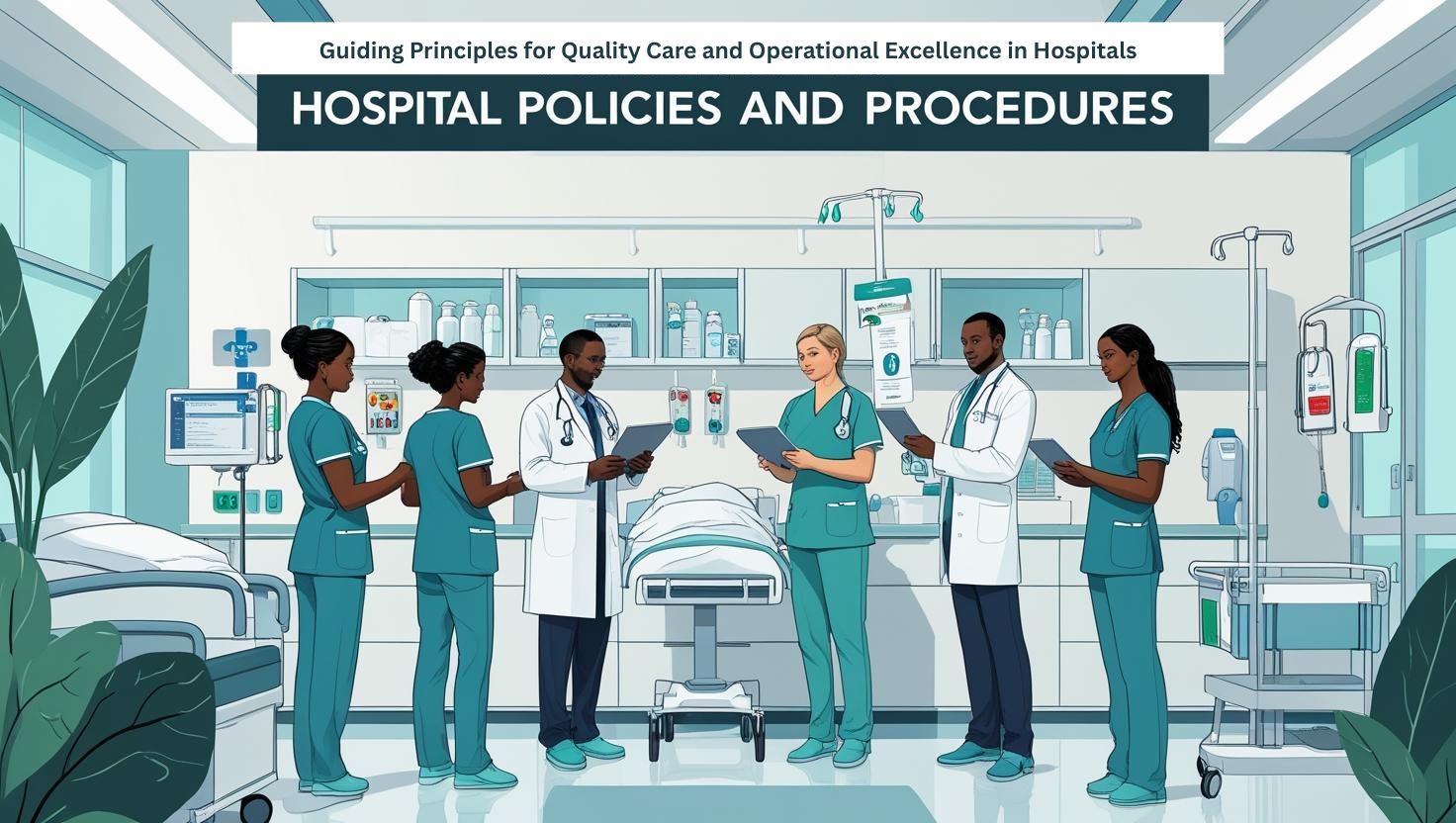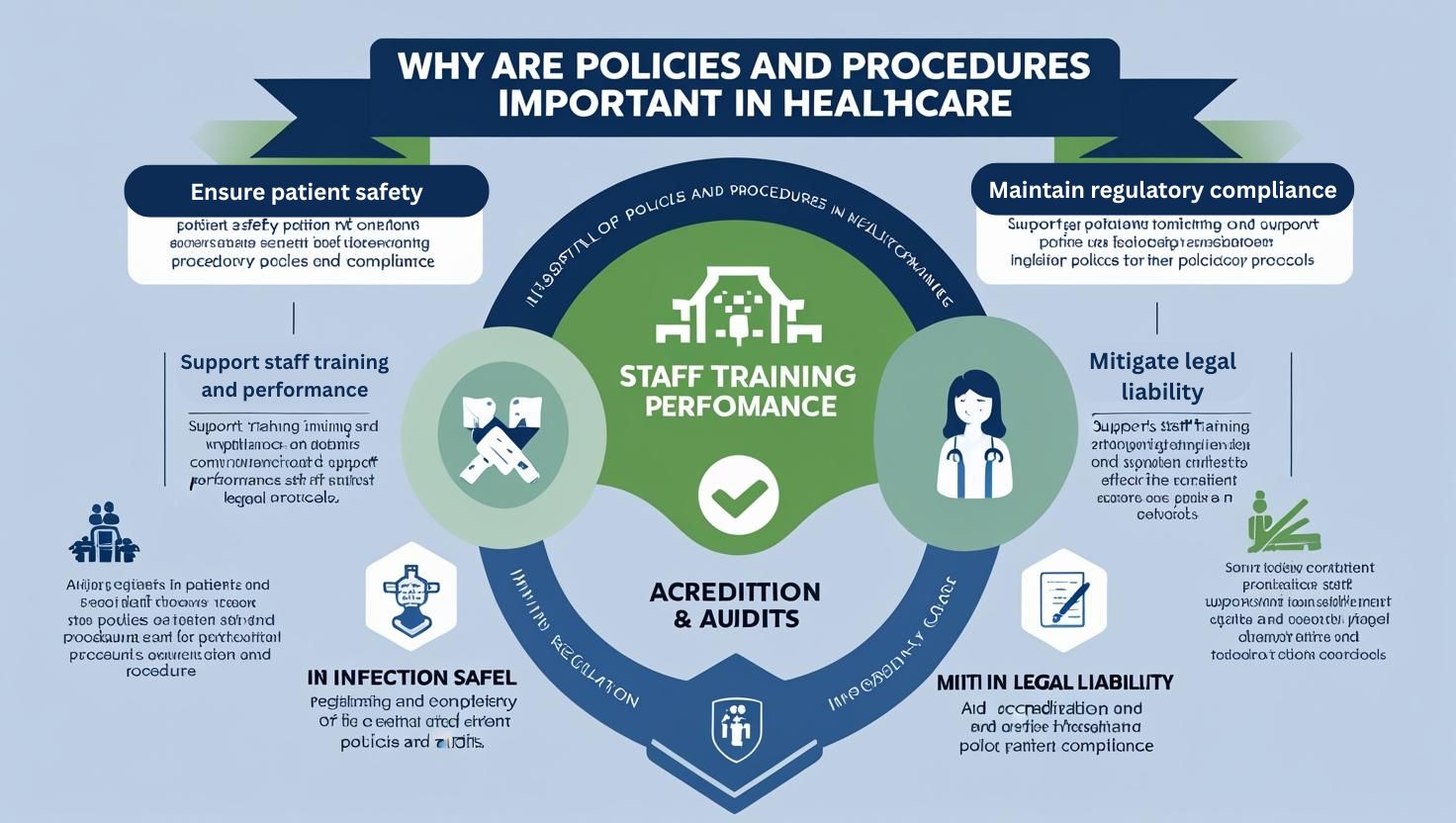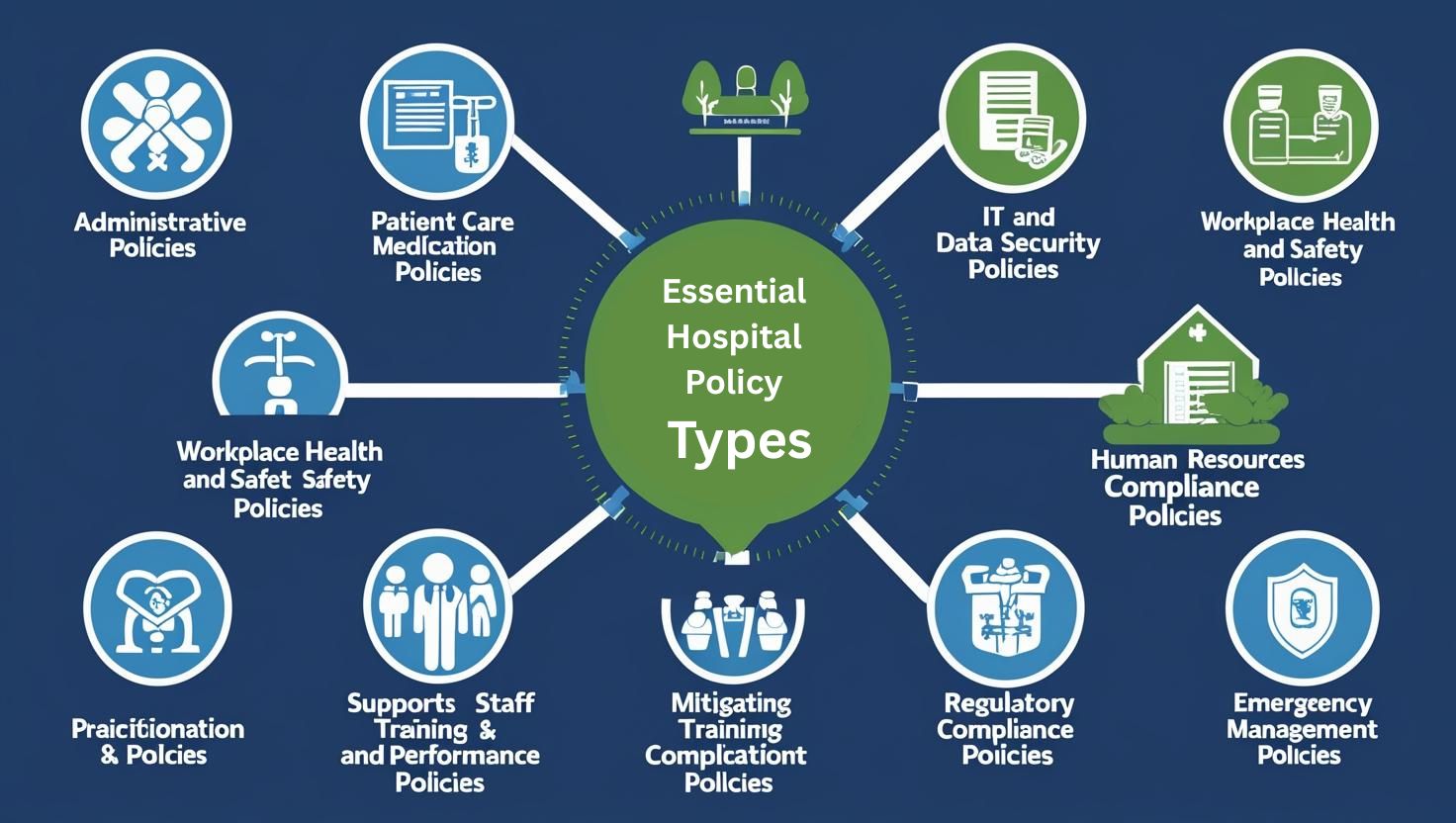
Hospital policies and procedures aren’t just bureaucratic hurdles—they are the foundation for effective communication and behaviors within a complex healthcare environment. In fact, robust communication, largely formalized through these very guidelines, can dramatically reduce workplace errors, 85% of which result from communication failures.
Keep reading to explore the fundamental differences, creation, and management of these vital communication elements and understand their link to enhancing patient safety, ensuring regulatory compliance, and streamlining hospital operations.
What are Hospital Policies and Procedures?
Misconceptions between policies and procedures often lead to inconsistent practices, errors, and confusion in hospital settings. So, let’s set the record straight on their distinctions.
A policy is a broad, high-level statement of principle or intent that guides decisions and actions within the hospital. It outlines what the organization aims to achieve and why it’s important, reflecting the hospital’s values, mission, and regulatory obligations.
Policies establish parameters and expectations for conduct and performance.
A procedure is a detailed, step-by-step set of instructions that explains how to implement or carry out a specific policy or perform a recurring task. It outlines the sequence of actions required to achieve a consistent and desired outcome.
Procedures translate broad policies into actionable steps.
Policies and procedures are inextricably linked and work in tandem. A policy without a corresponding procedure is merely a good intention, lacking the practical steps for implementation (i.e., lacking the how). Conversely, a procedure without a policy lacks the underlying rationale and guiding principle (i.e., lacking the why).
Why are Policies and Procedures Important in Healthcare?

Policies and procedures are critical in healthcare, especially in hospitals, because they:
- Ensure patient safety. They standardize care processes, reducing variability and the likelihood of errors, directly safeguarding patient well-being.
- Maintain regulatory compliance. They codify adherence to federal laws like HIPAA and mandates from governmental agencies such as OSHA, preventing legal penalties and maintaining operational legitimacy.
- Support staff training and performance. They provide clear guidance for employees, facilitating consistent performance and serving as essential training tools for new hires.
- Mitigate legal liability. They demonstrate a commitment to due diligence and industry standards, providing a defense against malpractice claims and legal challenges by proving adherence to regulations and established best practices.
- Aid in accreditation and audits. They serve as verifiable evidence that an organization meets rigorous external standards, making them indispensable for successful surveys by The Joint Commission (TCJ) and regulatory audits from other entities.
Who Creates Hospital Policies and Procedures?
Hospital policies and procedures are created through a collaborative process, often led by a dedicated policy committee or the quality/compliance department. Key stakeholders include:
- Subject matter experts. Clinicians, department managers, and specialists who understand daily operations and best practices can contribute key framing and high-level insights.
- Legal and compliance. These groups ensure adherence to laws (e.g., HIPAA, OSHA) and regulatory standards (e.g., TCJ).
- Leadership. Hospital administrators and executive teams provide strategic oversight and final approval.
- Staff input. Frontline staff offer valuable insights on feasibility and practicality.
The process of policy and procedure development involves drafting, reviewing, revising, and ultimately approving documents, with ongoing feedback loops for continuous improvement.
Interested in seeing how a real organization created and standardized their policies? Check out this case study on one health system’s journey to consolidating the policy and procedure libraries of 16 individual hospitals into a shared repository.
8 Essential Hospital Policy Types (with Examples)

While a complete list of hospital policy types would be exhaustive, we’ve compiled a collection of eight important types you should address at your facility, along with an example policy for each type.
Administrative Policies
Administrative hospital policies govern overall business operations, resource allocation, and general record keeping. They ensure smooth organizational functioning and compliance with administrative standards.
Example policy: The Financial Management Policy may mandate that all patient billing and payment processing adhere to established departmental guidelines, ensuring accuracy, transparency, and timely submission of claims to third-party payers while maintaining strict compliance with federal and state regulations.
Patient Care Policies
Policies that focus on patient care and safety detail how medical professionals deliver patient care, from admission and charting to treatment protocols and discharge. These are often department specific and ensure consistent, high-quality care.
Example policy: The Patient Admission Policy may state that upon admission, all patients will undergo a standardized initial assessment within four hours, including vital signs, medical history review, and the development of a preliminary care plan, by the assigned nursing staff and be documented accurately in the EHR.
Medication Policies
Critical for preventing errors, medication policies cover all aspects of pharmaceuticals: prescription, dosage, storage, handling, and disposal. They aid in ensuring patient safety and compliance.
Example policy: The Medication Administration Policy may require that nurses perform a “five rights” check—right patient, right drug, right dose, right route, right time—before administering any medication. They must verify physician orders against the medication label and patient wristband as well as document administration immediately afterwards.
IT and Data Security Policies
Policies surrounding data security are essential for protecting sensitive patient information and ensuring regulatory compliance (e.g., HIPAA). They typically cover aspects such as data privacy, cybersecurity, EHR usage, and system downtime protocols.
Example policy: The Protected Health Information (PHI) Access Policy may state that access to electronic PHI is restricted to authorized personnel only, based on their job function and unique login credentials. All access attempts shall be logged and regularly audited for security breaches.
Workplace Health and Safety Policies
Designed to protect both patients and staff from hazards, workplace health and safety policies address personal protective equipment (PPE) use, hazardous substance exposure, physical safety, and employee wellness, among other areas.
Example policy: The Bloodborne Pathogen Exposure Control Policy may mandate that all staff with potential exposure to bloodborne pathogens utilize universal precautions, including appropriate PPE, and follow immediate post-exposure protocols, including reporting and medical evaluation, as outlined in the facility’s exposure control plan.
Human Resources Policies
HR policies govern employee matters, including recruitment, benefits, leave, conduct, and discipline. They ensure fair treatment, consistent practices, and compliance with labor laws.
Example policy: The Employee Conduct Policy may indicate that all employees are expected to uphold professional conduct, respect colleagues and patients, and adhere to the hospital’s ethical guidelines and anti-harassment policies to ensure a positive and productive work environment.
Regulatory Compliance Policies
Regulatory compliance policies ensure adherence to healthcare laws, ethical standards, and relevant regulations stemming from federal laws such as HIPAA, governmental agencies like OSHA, and accrediting bodies such as the TCJ. These policies mitigate legal risks and ensure hospitals meet external mandates.
Example policy: The HIPAA Compliance Policy may direct all staff to maintain patient confidentiality as mandated by HIPAA by discussing patient information only in private settings for treatment or payment purposes as well as obtaining written patient consent for any other disclosures.
Emergency Management Policies
Emergency management policies outline safe ways to respond to various emergencies (e.g., disasters, pandemics). They cover preparedness, response, recovery, and mitigation to ensure safety during crises.
Example policy: The Fire Response and Evacuation Policy may state that in the event of a fire, staff must immediately activate the fire alarm, use R.A.C.E. (Rescue, Alarm, Confine, Extinguish/Evacuate) procedures, and guide patients to designated safe zones or evacuation routes as practiced in regular drills.
How Do Hospital Policies Ensure Compliance?
Hospital policies are the cornerstone of effective regulatory compliance in healthcare. They translate complex laws, such as those mandated by HIPAA and OSHA, and accreditation standards from organizations like TCJ into actionable guidelines.
By clearly outlining expected practices and staff behaviors, policies ensure consistent adherence to legal and ethical requirements. They serve as documented evidence of the hospital’s commitment to patient safety, data privacy, and quality care, thereby minimizing the risk of non-compliance, penalties, and reputational damage.
How Should Hospitals Manage and Maintain Policy Manuals?
The frequency of updates for hospital policies versus procedures is a key differentiator that hospital administrators must manage effectively as it impacts resource allocation, liability concerns, and more.
In general, procedures require more frequent updates than policies as policies are built on fundamental principles, legal mandates, and ethical stances. These foundational elements tend to change less rapidly than the specific methods for carrying them out. So, it may be several years between policy updates.
In contrast, procedures are the granular “how-to” steps. They are highly susceptible to changes in clinical best practices, technology, equipment, and even minor process improvements. So, annual or even quarterly updates may be the norm for some hospitals.
Best Practices for Managing Hospital Policy Manuals
With the above context in mind, follow these best practices for keeping your hospital policies and procedures up to date:
- Establish clear review cycles. Schedule regular reviews for both policies and procedures, with more frequent updates for procedures due to the factors above.
- Transition to a centralized, digital platform. Moving away from paper ensures all staff access the most current versions immediately, eliminates physical distribution burdens, and improves searchability, which significantly reduces the risk of following outdated procedures.
- Implement robust version control. Track all changes, revisions, and approval dates to maintain an accurate audit trail.
- Integrate with training. Link policies to required training and conduct regular, engaging education sessions on policy updates, emphasizing the why behind changes and their impact on daily practice to ensure staff comprehension and adherence.
- Ensure accessibility and mandatory staff acknowledgment. Policies must be easily found by all relevant personnel, and staff acknowledgement of new or updated documents should be tracked.
The Future of Hospital Policies in a Post-COVID, AI-Enhanced World

The future of hospital policies is profoundly shaped by recent trends. In our post-COVID world, healthcare facilities are creating policies that solidify remote care models and address licensure, reimbursement, and data security for expanded telehealth and remote monitoring.
Additionally, pandemic response lessons are encouraging facilities to embed robust policies for surge capacity, supply chain resilience, infection control, and dynamic communication approaches, thereby creating more adaptable and resilient healthcare systems.
Lastly, rising AI integration demands new policies for ethical use, data governance, algorithmic bias, and human oversight in clinical decision support and administrative automation.
Give Your Hospital’s Policies and Procedures Proper Care
Well-considered policy and procedure manuals are key to ensuring regulatory compliance and optimal patient care in hospitals large and small.
Ensure you receive all these benefits in full by partnering with EDC, the experts in medical documentation, including policy and procedure manuals for all categories of healthcare institutions.
Our consultants have extensive technical writing expertise across the various types of documentation. Whether you need a single technical writer for an ad-hoc documentation project or a team of consultants to produce a complete line of documents, EDC’s documentation services ensure your organization receives the highest quality policy manuals, procedural guides, other key organizational documents.
Plus, our clients work closely with an engagement manager from one of our 30 local offices for the entire length of your project at no additional cost.
Contact us at (800) 221-0093 or [email protected] to get started with your technical documentation.
FAQs
- What are hospital policies and procedures?
Hospital policies are high-level guidelines that direct decisions and behavior within a healthcare facility, while procedures are step-by-step instructions to carry out those policies consistently. - Why are hospital policies and procedures important?
They ensure patient safety, maintain legal and regulatory compliance, standardize staff performance, and reduce the risk of errors and liability. - What is the difference between a hospital policy and procedure?
A policy outlines what should be done and why, whereas a procedure details how to do it step by step. - Who is responsible for creating hospital policies?
Policy creation is typically a collaborative effort involving compliance teams, hospital leadership, legal advisors, clinical experts, and frontline staff. - What are examples of common hospital procedures?
Examples include patient admission steps, medication administration, surgical checklists, hand hygiene protocols, and emergency response drills. - How do hospital policies help with regulatory compliance?
They translate legal and accreditation standards into clear actions, ensuring compliance with HIPAA, OSHA, The Joint Commission, and more. - How often should hospital procedures be updated?
Procedures should be reviewed at least annually due to changes in clinical best practices, technologies, and equipment, while policies may need less frequent updates. - What types of hospital policies are most important?
Essential policy types include administrative, patient care, medication safety, IT/data security, HR, regulatory compliance, emergency response, and workplace safety. - How is AI influencing hospital policy creation?
AI is prompting new policies around algorithmic transparency, data governance, ethical decision support, and cybersecurity in digital health ecosystems.
Read more about: Healthcare SOPs for COVID-19
